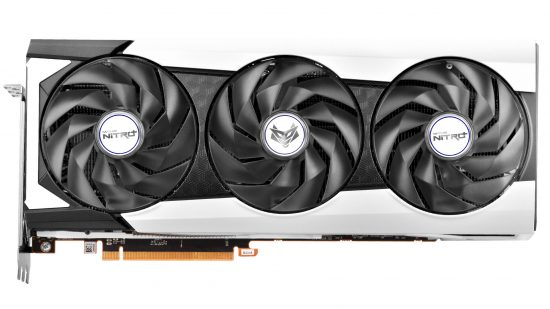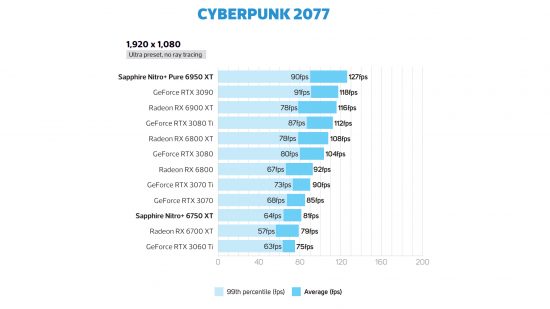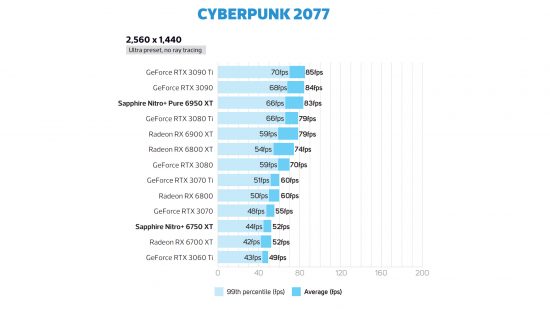Our Verdict
74%A really well-designed and well-built high-end graphics card from Sapphire. This is as good as RDNA2 gets with air cooling, although the Radeon RX 6950 XT still struggles with ray tracing.
Remember those halcyon days when a $1,300 gaming GPU price tag seemed extortionately expensive, rather than comparatively good value after two years of chaos? While Nvidia’s all-out Ampere swansong, the GeForce RTX 3090 Ti will set you back at least $1,999, AMD is hoping to tempt 4K gamers its way with the much cheaper Radeon RX 6950 XT.
At Custom PC, we’ve been reviewing the latest gaming GPUs since 2003, and we run a number of grueling benchmarks in order to gauge performance. Our game tests include measuring the frame rate in Cyberpunk 2077, Doom Eternal, and Metro Exodus, all with and without ray tracing, and we also test with Assassin’s Creed Valhalla. For more information, see our How we test page.
Of course, the GeForce RTX 3090 Ti isn’t just a speed-binned RTX 3090 with higher clock speeds – it also has two extra Streaming Multiprocessors enabled, giving it a (very slight) advantage in parallel shading power. Comparatively, the Radeon RX 6950 XT’s Navi 21 GPU is the same as that of the Radeon RX 6900 XT – it just has faster clock speeds.
In the case of our Sapphire Nitro+ Pure Radeon RX 6950 XT test sample, though, Sapphire has paired these new speed-binned GPUs with a super-powerful PCB and cooler setup that frees the GPU to boost far beyond the stated spec.
AMD quotes a typical board power of ‘at least’ 330W for Radeon RX 6950 XT cards, with a 2100MHz game clock and 2310MHz boost clock. Comparatively, Sapphire quotes a 2162MHz game clock and 2368MHz maximum boost clock for the Nitro+ Pure Radeon RX 6950 XT, thanks to a 370W total board power.
What’s more, there’s the ability to push it up to 390W with a 2425MHz boost clock in its OC mode, enabled by swapping the card to a different set of BIOS settings. It comes with a handy BIOS switch on the top of the card, which enables you to switch between modes.

However, we found that the OC mode made little difference to performance, as the Sapphire card’s extra power and immense cooling system already frees up the GPU to boost much further than the stated specs. We observed a 2660MHz peak in our game tests, with the clock speed generally running at around 2555MHz, so we happily left the card running at its default settings.
AMD has also taken this opportunity to increase the memory clock speed from the Radeon RX 6900 XT’s 2GHz (16GHz effective) to the 6950 XT’s 2250MHz (18GHz effective), and Sapphire has left this setting alone.
As with the Radeon RX 6900 XT, you still get 16GB of GDDR6 memory attached to a 256-bit wide interface, but the 6950 XT’s extra clock speed boosts the total bandwidth from 512GB/sec to 575.5GB/sec. That’s still a long way off the 1TB/sec+ speeds Nvidia now commands, but the Radeon RX 6950 XT can also fall back on a 128MB pool of Infinity Cache to help here.

The Sapphire Radeon RX 6950 XT Nitro+ Pure
Sapphire has really gone to town on the Radeon RX 6950 XT Nitro+ Pure, building on the existing Nitro+ cooler design to create an enormous brick of a card that still manages to look attractive. It’s wrapped in a well-engineered, two-part chunky white metal frame (the Pure in the name refers to this color) made from die-cast aluminum-magnesium alloy.
It’s peppered with large vent holes to allow the heatsinks beneath it to breathe, and the backplate part is thermally attached to the PCB with a pad. The card also has three areas of ARGB lighting – two on the back and one on the edge. The trio of fans also sport ARGB lighting, but it’s hard to see them through a case window on a card that’s this thick and, let’s face it, you’re not going to put this 3.5-slot monster in a vertical GPU mount.
The lighting can be controlled through Sapphire’s Trixx software, which also offers options for creating custom resolutions to improve performance, along with temperature and clock speed monitoring features, and the ability to switch between BIOSes.

There are a number of lighting effects available, although custom colors are disappointingly left static, with no way to cycle between two custom colors, for example. Thankfully, Sapphire has also provided another option, with a standard 3-pin RGB cable on the edge of the PCB, which you can access under a backplate vent to tie the card to your own lighting control system.
You also get a support bracket in the box, although we found that the card’s thick metal frame already prevented the card from drooping in our test rig. It’s a well-built hunk of metal with a solid structure.
One definite advantage of this Sapphire card is its awesome cooler. It remained barely audible throughout testing, with its noise always eclipsed by the 240mm AIO liquid cooler on our CPU. That’s amazing for a card that’s regularly achieving such high clock speeds.
The latter shows that there aren’t any throttling problems too, and we measured a GPU peak temperature of 71°C during testing, with a junction temperature of 88°C (Sapphire claims 74°C and 89°C for these results respectively).

RX 6950 XT Assassin’s Creed Valhalla frame rate
While the Radeon RX 6950 XT doesn’t offer any extra stream processors or Ray Accelerators over its predecessor, the extra clock speed does make a difference. In particular, this is the fastest card we’ve ever tested in Assassin’s Creed Valhalla – here, the Sapphire Nitro+ Pure 6950 XT’s average frame rate of 72 fps even beats the GeForce RTX 3090 Ti by 3fps at 4K with Resizable BAR enabled, and by larger margins at lower resolutions, which is where extra clock speed usually makes a bigger difference.
For this game, we also forced the Sapphire card down to AMD’s reference spec to see how much more power you get from the Nitro+ Pure. While the reference spec Radeon RX 6950 XT’s average frame rates are 3-6fps quicker than those of the Radeon RX 6900 XT, the immense boosting power of the Sapphire card pushes it much further – it gets you an extra 6fps than the reference spec at 4K, and 14fps more at 1,920 x 1,080.
RX 6950 XT Doom Eternal frame rate
The Radeon RX 6950 XT is a fantastic GPU for running Doom Eternal. It smashed the competition in our benchmark at 1,920 x 1,080 with an average frame rate of 499 fps, and its average frame rate of 404 fps wasn’t far behind the GeForce RTX 3090’s 408 fps, although the Radeon RX 6950 XT’s 99th percentile result of 268 fps eas a fair bit behind the RTX 3090’s 303 fps.
Where the Radeon RX 6950 XT starts to struggle in this is game is when you enable ray tracing. Its average frame rate of 193 fps at 2,560 x 1,440 is fine, but it’s a long way behind the 282 fps of the GeForce RTX 3090 Ti. It really hits the buffers at 4K too, with the 99th percentile result dropping to 68 fps, compared with 110 fps on the GeForce RTX 3090 Ti.
RX 6950 XT Metro Exodus frame rate
If you don’t enable ray tracing, the Radeon RX 6950 XT plays Metro Exodus well, with an average frame rate of 76 fps at 4K and a 99th percentile result of 50 fps. This is in a similar league to the GeForce RTX 3090 Ti, which has a higher average of 83 fps, but lower 99th percentile result of 47 fps.
However, the Radeon RX 6950 XT starts to lag behind once you enable ray tracing in Metro Exodus. The Radeon RX 6950 XT still copes well here, with an average frame rate of 78 fps at 2,560 x 1,440, and 99th percentile result of 52 fps, but this is where it falls behind the GeForce RTX 3080 and GeForce RTX 3080 Ti.
RX 6950 XT Cyberpunk 2077 frame rate
If you don’t enable ray tracing, the Radeon RX 6950 XT copes remarkably well in Cyberpunk 2077, with an average frame rate of 83 fps at 2,560 x 1,440, and a 99th percentile result of 66 fps. This is similar to the performance of the GeForce RTX 3090. However, it really struggles when you enable ray tracing.
With Medium ray tracing enabled, the Radeon RX 6950 XT’s average frame rate of 32 fps is a long way behind the 51 fps of the GeForce RTX 3090 Ti. If you enable FSR, you can push this up to an average frame rate of 62 fps, with a 99th percentile result of 52 fps, which is fine. However, you can’t play this game with Medium ray tracing at 4K on the Radeon RX 6950 XT, even with FSR enabled – the average frame rate is only 37 fps.
RX 6950 XT power draw
Despite the sky-high clock speeds of this Sapphire Nitro+ Pure card, and the need for three power connectors (2 x 8-pin and 1 x 6-pin), the peak total system power consumption of 558W with this Sapphire card was 133W lower than with the new GeForce RTX 3090 Ti. It’s not exactly power-frugal, but there are worse examples in the high-end GPU market.
RX 6950 XT pros and cons
Pros
- Sapphire Nitro+ Pure card has fantastic design
- Amazing boost speeds
- Very fast at rasterization
Cons
- Struggles with ray tracing
- High price
Radeon RX 6950 XT specs
The Radeon RX 6950 XT specs list is:
| Stream processors | 5,120 |
| RT cores | 80 |
| ROPs | 128 |
| Game clock | 2100 MHz |
| Max boost clock | 2310 MHz |
| Memory | 16GB GDDR6 |
| Memory clock | 2250 MHz (18 GHz effective) |
| Memory bandwidth | 575.5 GB/s |
| Memory interface | 256-bit |
| L3 cache | 128 MB |
| Card interface | 16x PCIe 4 |
| Power connectors | 2 x 8-pin |
| Expansion slots | 3 |
RX 6950 XT price
Price: Expect to pay $1,300 (£1,200)
RX 6950 XT review conclusion
The Sapphire Nitro+ Pure Radeon RX 6950 XT is a triumph in terms of card design, allowing great boost clocks without making a racket, and all packaged in a satisfyingly well-built and good-looking chunk of expansion card.
Its only problem is that the GPU on which it’s based can’t handle ray tracing as well as the competition from Nvidia, and if you’re spending this much money on a new graphics card, you’re going to want to enable the top eye candy. If ray tracing isn’t important to you, though, this is an awesomely powerful, well-built graphics card.
For more gaming GPU options, check out our full guide to the best graphics card, which has a range of cards at different prices.








































